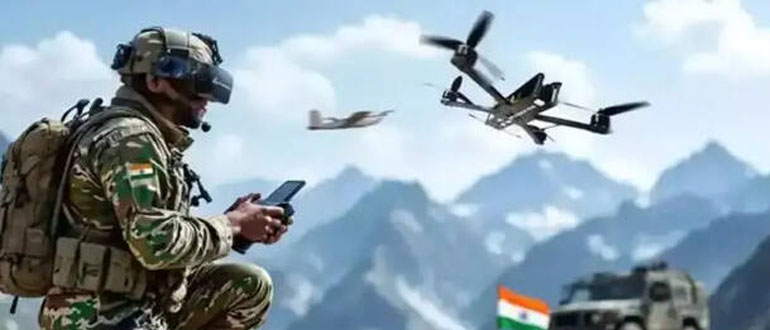Srinagar| WTNS | Sep 01:The mountains remember. They remember the footsteps of soldiers, the echo of artillery, the sharp whistle of wind over peaks that scrape the sky. Along these jagged ridges, where the earth falls away in chasms of stone and snow, India has sent its newest children: the Bhairav Commandos.
By Agha Syed Amin Musvi | Wilayat Times
The mountains remember. They remember the footsteps of soldiers, the echo of artillery, the sharp whistle of wind over peaks that scrape the sky. Along these jagged ridges, where the earth falls away in chasms of stone and snow, India has sent its newest children: the Bhairav Commandos.
They are small battalions two hundred and fifty men each—but their presence is vast. Drawn from ordinary infantry, they are being remade. They will be broken, shaped, disciplined, and then tested. For two or three months, they will train in the regimented confines of their regimental centres, running over the hard earth, over hills that bruise the ankles, over days that stretch endlessly. After this, they will enter a month of advanced preparation with Special Forces, a passage into a world of precision, secrecy, and calculated risk. Their work will not make headlines. Their victories will not be sung. They are watchers, disruptors, guardians of spaces where chaos could grow.
Five battalions are to be formed by October. Three along the northern borders, facing China and Pakistan, where the air is thin and the cold is sharp and unrelenting. Two along the east and west, in lands where history has a different cadence but danger moves just as swiftly. Each placement is deliberate, a conversation with geography, with memory, with the inevitable tension that clings to every border.
The Shape of Modern War
This is not the war of drumbeats and marching columns. This is the war of drone eyes and loitering munitions, of artillery that moves like liquid through mountains and plains. The Bhairav Commandos are not alone. They are part of a larger experiment, alongside units named Rudra, Shaktibaan, Divyastra words that sound like prayers, or spells, or warnings.
After the flare-up with Pakistan in May, the Army realised what has always been true but often ignored: courage alone is insufficient. Precision, intelligence, speed—these are the weapons that decide modern battles. The artillery no longer acts in isolation. Infantry, armour, artillery—they move together as one organism, responding to threats, anticipating danger, striking when opportunity and inevitability meet.
“Every infantry battalion now has drone platoons,” said General Upendra Dwivedi, Chief of Army Staff. “The artillery’s lethality has been enhanced through Divyastra batteries and loitering munitions. The Army Air Defence is being upgraded with indigenous missile systems.” The words are simple, but they contain worlds—transformation, anticipation, readiness.
Elegance in Violence
The Shaktibaan regiments are almost lyrical. Drones circle their targets with patient detachment, waiting for the precise moment to strike, hovering like birds over the ridges. Divyastra batteries merge the old and the new, artillery guided by intuition as much as by sight and data. Together, they make the battlefield a place where violence is precise, controlled, and almost elegant. It is not beauty in the sense of pleasure—it is beauty in the sense of inevitability, inevitability in action, inevitability in outcome.
Soldiers Between Silence and History
The Bhairav Commandos guard more than territory. They guard a philosophy: that vigilance need not announce itself, that courage is inseparable from thought, that readiness is an art as well as a duty. They guard a country whose frontiers have known conquest, betrayal, and defiance. Every movement, every deployment, every calculation carries a weight that is both physical and symbolic.
These men carry the silence of mountains, the whisper of valleys, the echo of rivers. They move with deliberation, strike with calculation, and exist in the liminal spaces where history is written and forgotten. They are guardians of memory as much as they are guardians of borders.
Geography as Teacher
To understand the Bhairav Commandos is to understand the land they inhabit. The northern frontier is a place of extremes: high-altitude deserts, cliffs that fall into nothingness, weather that can kill as easily as any enemy. The east and west are different landscapes—dense forests, rivers that twist like serpents, plains that stretch into mirages. In each place, the soldier learns to listen, to move, to survive. Geography is their instructor, and it is unyielding.
The Weight of Technology
Yet geography alone is not enough. Modern war demands intelligence that can see before the eyes see, strike before the hand moves. Drones hover like silent, unblinking witnesses. Loitering munitions lie in wait like patient predators. Communication networks pulse like veins through the landscape. Every move of the Bhairav Commandos is supported, guided, and amplified by technology, but never replaced. They remain human, deliberate, aware. The human mind is still the battlefield’s ultimate instrument.
Guardians of Possibility
And so they stand at the edge of memory and possibility. They are neither loud nor boastful. They are not even particularly visible. They are the answer to questions that no one has dared to ask aloud: How do you prepare for a threat that is always moving? How do you act in places that are almost too beautiful and too deadly to behold? How do you guard a nation whose borders are more than lines on a map—they are histories, promises, and fragile claims woven over centuries?
The Bhairav Commandos are both answer and question. They are action and reflection. They are discipline and poetry. They are soldiers shaped by mountains, by history, by necessity, by vision.
As these battalions prepare to step into their theatres, they carry with them the weight of mountains, the patience of valleys, and the inevitability of time itself. They are the sentinels of modern India, guardians of both land and narrative, standing where the visible world meets the invisible: where courage, calculation, and readiness converge.



